Introduction
The Snow Leopard Network is dedicated to the preservation and protection of the snow leopard and its habitat. This article delves into the Network’s key objectives, including their conservation strategies, research initiatives, and the vital role of community involvement
We will also explore their support for sustainable development, various partnerships, and the methods they employ to address threats to snow leopards. By understanding these efforts, we gain insight into the comprehensive approach taken by the Snow Leopard Network to ensure the survival and thriving of this majestic species in the wild
Conservation Strategies of the Snow Leopard Network
The Snow Leopard Network (SLN) employs a multi-faceted approach to conservation, focusing on habitat preservation, anti-poaching efforts, and restoration projects. These strategies are crucial for ensuring the long-term survival of snow leopards and maintaining the ecological balance of their habitats
Habitat Preservation Initiatives
Preserving the natural habitats of snow leopards is a cornerstone of SLN’s conservation strategy. The organization collaborates with local and international partners to protect and manage key habitats across the snow leopard’s range
Efforts include creating and maintaining protected areas, such as national parks and wildlife reserves, where human activity is limited and controlled to minimize habitat destruction and fragmentation. For instance, SLN has worked with the governments of countries like Mongolia and Kyrgyzstan to establish large conservation areas that are crucial for snow leopard populations
In addition to protected areas, SLN promotes habitat connectivity by establishing wildlife corridors that allow snow leopards to move freely between different regions. These corridors are essential for genetic diversity and reducing inbreeding within isolated populations
The organization also advocates for sustainable land-use practices that balance human needs with wildlife conservation, ensuring that agricultural and development activities do not encroach on critical snow leopard habitats
Anti-Poaching Measures
Poaching remains one of the most significant threats to snow leopards, driven by the demand for their fur and bones in illegal wildlife trade. SLN has implemented robust anti-poaching measures to combat this threat
These measures include training and deploying anti-poaching patrols in high-risk areas. These patrols work closely with local communities and law enforcement agencies to monitor and protect snow leopards and their prey species
SLN also utilizes advanced technology such as camera traps and drones to monitor poaching activities and gather data on poacher movements and techniques. By combining traditional knowledge with modern technology, SLN has been able to significantly reduce poaching incidents in several key areas
For example, in parts of India and Nepal, the implementation of these measures has led to a notable decline in poaching activities, contributing to the stabilization of local snow leopard populations
Restoration Projects
Restoration projects are another vital component of SLN’s conservation strategy
These projects aim to rehabilitate degraded habitats and restore ecological balance. SLN collaborates with environmental scientists, local communities, and government agencies to implement restoration activities such as reforestation, soil erosion control, and water resource management
One of the notable restoration projects involves the reintroduction of native prey species into areas where they have been depleted due to overhunting and habitat loss. By restoring prey populations, SLN helps to ensure that snow leopards have a stable food source, which is crucial for their survival and reproductive success
Additionally, these restoration efforts contribute to the overall health of the ecosystem, benefiting a wide range of plant and animal species
SLN also focuses on mitigating the impacts of climate change on snow leopard habitats. This includes activities like planting climate-resilient vegetation and implementing water conservation measures to maintain the availability of water resources in arid and semi-arid regions
These efforts help to create a more resilient environment that can withstand the effects of climate change, ensuring the long-term viability of snow leopard habitats
Research Conducted by the Snow Leopard Network
Research is a fundamental component of the Snow Leopard Network’s mission, providing critical insights into snow leopard behavior, ecology, and population dynamics. The Network employs various research methods to gather data, inform conservation strategies, and enhance the understanding of snow leopards in their natural habitats
Population Monitoring Techniques
Accurate population monitoring is essential for assessing the status of snow leopard populations and guiding conservation efforts. The Snow Leopard Network employs several innovative techniques to monitor snow leopard populations across their range
Camera trapping is one of the primary methods used, involving the strategic placement of motion-sensitive cameras in snow leopard habitats. These cameras capture images and videos of snow leopards as they move through the landscape, providing valuable data on population size, density, and distribution
Another key technique is genetic sampling, which involves collecting and analyzing DNA from snow leopard scat (feces), hair, and other biological samples. Genetic analysis helps identify individual snow leopards, assess genetic diversity, and understand population structure. This method has been particularly useful in remote and rugged areas where direct observation of snow leopards is challenging
In addition to camera trapping and genetic sampling, SLN also utilizes radio collaring to track the movements and behavior of individual snow leopards
Radio collars equipped with GPS technology provide real-time data on the locations and movements of collared snow leopards, offering insights into their home ranges, migration patterns, and interactions with other individuals. This information is crucial for understanding snow leopard ecology and developing effective conservation strategies
Behavioral Studies
Understanding the behavior of snow leopards is vital for effective conservation planning. SLN conducts detailed behavioral studies to gain insights into various aspects of snow leopard life, including hunting strategies, social interactions, and reproductive behavior. These studies often involve direct observation, camera trap footage, and radio collar data
One area of focus is the hunting behavior of snow leopards. Researchers study how snow leopards hunt and capture their prey, which typically includes species such as blue sheep, ibex, and Himalayan tahr. By understanding hunting strategies and prey preferences, SLN can identify critical prey species that need protection to support snow leopard populations
Social behavior is another important research area. Snow leopards are generally solitary animals, but understanding their social interactions, territoriality, and mating behavior can provide valuable insights into population dynamics and reproductive success. For example, researchers have observed that snow leopards use scent marking and vocalizations to communicate with each other and establish territories
Reproductive behavior studies focus on understanding mating systems, cub rearing, and factors influencing reproductive success. This information is crucial for managing captive breeding programs and ensuring the long-term survival of snow leopard populations in the wild
Genetic Research
Genetic research plays a critical role in snow leopard conservation by providing insights into genetic diversity, population structure, and evolutionary history. SLN collaborates with geneticists and molecular biologists to conduct comprehensive genetic studies using advanced techniques such as DNA sequencing and microsatellite analysis
One of the primary goals of genetic research is to assess the genetic health of snow leopard populations
High levels of genetic diversity are essential for the long-term survival of species, as they enhance adaptability to environmental changes and reduce the risk of inbreeding. Genetic studies help identify populations with low genetic diversity that may require targeted conservation efforts to increase genetic variability
Genetic research also contributes to understanding the evolutionary history of snow leopards and their relationships with other big cat species. By analyzing genetic markers, researchers can trace the evolutionary lineage of snow leopards, identify distinct populations, and uncover historical patterns of migration and gene flow
This information is valuable for developing conservation strategies that preserve the genetic integrity of snow leopard populations
In addition to these primary research areas, SLN also investigates the impacts of climate change on snow leopards and their habitats. Climate change poses significant threats to snow leopards by altering their habitats, affecting prey availability, and increasing the risk of human-wildlife conflicts
SLN conducts climate modeling studies to predict future habitat changes and develop adaptation strategies to mitigate the impacts of climate change on snow leopard populations
Community Involvement in the Snow Leopard Network
Community involvement is a key pillar of the Snow Leopard Network’s (SLN) strategy to conserve snow leopards
Engaging local communities in conservation efforts ensures sustainable and long-lasting results, fostering a sense of ownership and responsibility towards protecting snow leopards and their habitats
Local Education Programs
Education is fundamental to building awareness and support for snow leopard conservation among local communities. SLN implements various education programs aimed at increasing knowledge about snow leopards and the importance of biodiversity
These programs target different age groups, from school children to adults, and often involve interactive activities such as workshops, field trips, and wildlife camps
In many snow leopard habitats, local schools have incorporated snow leopard conservation into their curricula, teaching students about the species, its role in the ecosystem, and the threats it faces. These educational initiatives not only raise awareness but also inspire the younger generation to become advocates for conservation
SLN also conducts training sessions for local teachers, equipping them with the knowledge and resources needed to educate their students about wildlife conservation. By empowering teachers, SLN ensures that conservation messages reach a broader audience and become an integral part of the community’s education system
Community-Based Conservation
Community-based conservation is a cornerstone of SLN’s approach, involving local people directly in conservation activities. This approach acknowledges that local communities have a deep understanding of their environment and can play a crucial role in protecting it
SLN collaborates with community members to develop and implement conservation plans that address both the needs of the wildlife and the people
One successful example of community-based conservation is the establishment of Community Conservation Committees (CCCs) in various regions. These committees consist of local leaders, herders, and other community members who work together to monitor snow leopard populations, prevent poaching, and mitigate human-wildlife conflicts
The CCCs often coordinate anti-poaching patrols, report illegal activities, and raise awareness about the importance of conserving snow leopards
SLN also supports community-led initiatives such as predator-proof livestock corrals, which help reduce livestock losses to snow leopards and other predators. By minimizing conflicts between herders and snow leopards, these initiatives foster coexistence and reduce the retaliatory killing of snow leopards
Sustainable Livelihood Initiatives
To ensure the long-term success of conservation efforts, SLN promotes sustainable livelihood initiatives that provide economic benefits to local communities while reducing their dependence on activities that harm snow leopard habitats. These initiatives aim to create alternative income sources that are compatible with conservation goals
One such initiative is the development of eco-tourism programs. Eco-tourism provides communities with financial incentives to conserve wildlife and natural habitats, as tourists are drawn to areas where they can observe snow leopards and other unique wildlife
SLN works with local communities to develop eco-friendly tourism infrastructure, train guides, and create tourism packages that highlight the region’s natural and cultural heritage
Another sustainable livelihood initiative involves supporting handicrafts and other traditional crafts that can be sold in local and international markets. SLN collaborates with artisans to improve product quality, market access, and fair pricing. By promoting traditional crafts, SLN helps preserve cultural heritage while providing communities with additional income
SLN also promotes sustainable agriculture and livestock practices that minimize environmental impact. This includes training farmers in organic farming techniques, promoting crop diversification, and supporting the use of renewable energy sources. These practices not only benefit the environment but also improve food security and resilience to climate change
Supporting Sustainable Development
The Snow Leopard Network (SLN) recognizes that sustainable development is crucial for the long-term conservation of snow leopards and their habitats
By promoting eco-friendly practices, collaborating with local businesses, and conducting environmental impact assessments, SLN ensures that conservation efforts align with the broader goals of sustainable development
Eco-Friendly Practices
Implementing eco-friendly practices is essential to reducing the ecological footprint of human activities in snow leopard habitats. SLN promotes various initiatives that encourage sustainable resource use and minimize environmental degradation
One such initiative is the promotion of renewable energy sources, such as solar and wind power, in remote communities. By reducing reliance on fossil fuels, these communities can decrease their carbon footprint and mitigate the impacts of climate change on snow leopard habitats
SLN also advocates for sustainable land-use practices that balance conservation with agricultural and developmental needs. This includes promoting agroforestry, which integrates trees and shrubs into agricultural landscapes, providing multiple benefits such as soil conservation, enhanced biodiversity, and sustainable livelihoods
Additionally, SLN supports the implementation of water conservation techniques, such as rainwater harvesting and efficient irrigation methods, to ensure the sustainable use of water resources in arid and semi-arid regions
Collaborations with Local Businesses
Engaging local businesses in conservation efforts is a key strategy for promoting sustainable development. SLN collaborates with a range of businesses, from small enterprises to larger corporations, to develop practices that benefit both the environment and the local economy
For example, SLN works with local farmers and herders to improve livestock management practices, reducing overgrazing and land degradation while enhancing productivity and income
One notable collaboration is with the tourism industry, where SLN promotes eco-tourism as a sustainable economic activity
By training local guides, developing eco-friendly accommodations, and creating tourism packages that highlight snow leopards and their habitats, SLN helps generate income for local communities while fostering conservation awareness among visitors. These efforts ensure that tourism activities are conducted in a manner that minimizes environmental impact and supports the conservation of snow leopards
SLN also partners with businesses involved in the production and sale of traditional crafts. By supporting fair trade practices and helping artisans improve product quality and market access, SLN enhances the economic resilience of local communities while preserving cultural heritage
These collaborations provide alternative income sources that reduce dependency on activities that harm snow leopard habitats, such as logging and poaching
Environmental Impact Assessments
Conducting environmental impact assessments (EIAs) is crucial for ensuring that development projects do not negatively impact snow leopard habitats. SLN works with government agencies, developers, and environmental consultants to assess the potential impacts of proposed projects, such as infrastructure development, mining, and hydropower installations
EIAs involve a thorough evaluation of the potential environmental, social, and economic impacts of a project, followed by the development of mitigation measures to minimize negative effects
For example, in regions where mining activities threaten snow leopard habitats, SLN advocates for stricter regulations and the implementation of best practices to reduce habitat destruction and pollution
SLN also emphasizes the importance of involving local communities in the EIA process. By engaging community members in consultations and decision-making, SLN ensures that their knowledge and concerns are considered, leading to more effective and sustainable outcomes. This participatory approach not only enhances the credibility of the EIA process but also fosters community support for conservation initiatives
In addition to project-specific EIAs, SLN conducts broader environmental assessments to identify and address cumulative impacts on snow leopard habitats. These assessments help guide regional planning and development strategies, ensuring that conservation priorities are integrated into broader sustainable development goals
Partnerships and Collaborations
The Snow Leopard Network (SLN) thrives on a foundation of strong partnerships and collaborations with various stakeholders. These partnerships enhance the effectiveness of conservation efforts by pooling resources, expertise, and influence from a wide range of organizations and institutions
International Conservation Organizations
SLN collaborates with international conservation organizations to leverage their global reach and resources. These partnerships are essential for large-scale initiatives that require extensive funding, technical expertise, and international advocacy
For instance, SLN works closely with the World Wildlife Fund (WWF), the Wildlife Conservation Society (WCS), and Panthera, among others, to implement comprehensive conservation programs across snow leopard ranges
These collaborations involve joint research projects, coordinated anti-poaching efforts, and shared advocacy campaigns aimed at raising awareness and securing international support for snow leopard conservation. By aligning with globally recognized organizations, SLN enhances its credibility and amplifies its conservation impact
Governmental Agencies
Partnerships with governmental agencies are crucial for creating and enforcing policies that protect snow leopards and their habitats
SLN works with national and regional governments in snow leopard range countries to develop and implement conservation strategies, such as the Global Snow Leopard and Ecosystem Protection Program (GSLEP). This program, endorsed by 12 snow leopard range countries, aims to secure 20 snow leopard landscapes by 2020 through collaborative efforts involving governments, NGOs, and local communities
SLN also engages with government agencies to ensure that national laws and regulations support snow leopard conservation
This includes advocating for stronger anti-poaching laws, improved wildlife trade regulations, and enhanced habitat protection measures. By working with policymakers, SLN helps create an enabling environment for effective conservation
Non-Profit Alliances
Non-profit organizations play a vital role in snow leopard conservation, providing on-the-ground support and community engagement
SLN partners with a range of non-profits, such as the Snow Leopard Trust and the Snow Leopard Conservancy, to implement local conservation initiatives and community-based programs. These alliances are particularly important for grassroots efforts that require direct interaction with local communities
Non-profit partners assist SLN in conducting research, monitoring snow leopard populations, and implementing education and outreach programs. They also help mobilize volunteers and resources for conservation activities, such as anti-poaching patrols and habitat restoration projects. By collaborating with non-profits, SLN extends its reach and impact at the local level
Academic Institutions
Collaboration with academic institutions is essential for advancing scientific research on snow leopards. SLN partners with universities and research centers to conduct studies on snow leopard ecology, behavior, genetics, and conservation strategies
These partnerships provide access to cutting-edge research facilities and expertise, enabling SLN to generate high-quality scientific data that informs its conservation efforts
Academic partners also contribute to capacity building by training the next generation of conservationists and researchers. Through internships, field courses, and research collaborations, SLN helps develop skilled professionals who can contribute to snow leopard conservation in the future
Local Community Groups
Engaging local community groups is a cornerstone of SLN’s conservation strategy
These groups have intimate knowledge of their environments and are directly affected by conservation policies and practices. SLN collaborates with community-based organizations to implement conservation initiatives that align with local needs and priorities
Community groups play a crucial role in monitoring snow leopard populations, reporting poaching incidents, and mitigating human-wildlife conflicts. They also participate in sustainable livelihood programs that provide economic benefits while promoting conservation. By empowering local communities, SLN fosters a sense of ownership and responsibility towards snow leopard conservation
Addressing Threats to Snow Leopards
The Snow Leopard Network (SLN) is dedicated to tackling the numerous threats that snow leopards face, including human-wildlife conflict, climate change, and illegal wildlife trade. By addressing these threats, SLN works to create a safer and more sustainable environment for snow leopards and their ecosystems
Tackling Human-Wildlife Conflict
Human-wildlife conflict is one of the most significant threats to snow leopards. As human populations expand into snow leopard habitats, livestock predation by snow leopards often leads to retaliatory killings by herders. SLN employs several strategies to mitigate these conflicts and promote coexistence
One effective approach is the establishment of predator-proof livestock corrals. These structures protect livestock from snow leopard attacks, reducing the financial losses for herders and the retaliatory killings of snow leopards. SLN collaborates with local communities to design, fund, and build these corrals, providing a practical solution to a long-standing problem
SLN also implements livestock insurance programs, where herders receive compensation for livestock lost to snow leopard predation. These programs are designed to reduce the economic burden on herders, making them less likely to kill snow leopards in retaliation
In addition, SLN conducts community workshops to educate herders about non-lethal methods of protecting their livestock and promoting tolerance towards snow leopards
Reducing Climate Change Impacts
Climate change poses a significant threat to snow leopards by altering their habitats and affecting prey availability. SLN addresses these impacts through a combination of research, habitat management, and community engagement
Research efforts focus on understanding how climate change affects snow leopard habitats and developing predictive models to forecast future changes
SLN collaborates with climate scientists and ecologists to study the effects of rising temperatures, changing precipitation patterns, and shrinking glaciers on snow leopard habitats. These studies help identify vulnerable areas and inform conservation strategies
In terms of habitat management, SLN promotes climate-resilient practices such as reforestation and sustainable land use. By planting native vegetation and restoring degraded areas, SLN helps maintain the integrity of snow leopard habitats and enhances their resilience to climate change
Water conservation measures, such as building water catchments and improving irrigation efficiency, ensure that water resources remain available for both wildlife and human use
Community engagement is also crucial in addressing climate change impacts. SLN works with local communities to develop climate adaptation plans that incorporate traditional knowledge and modern scientific insights
These plans focus on sustainable agriculture, water management, and disaster preparedness, helping communities adapt to changing environmental conditions while supporting snow leopard conservation
Combatting Illegal Wildlife Trade
The illegal wildlife trade is a major threat to snow leopards, driven by demand for their fur, bones, and other body parts. SLN combats this threat through a combination of law enforcement, public awareness campaigns, and international cooperation
SLN supports law enforcement agencies in conducting anti-poaching patrols and investigating wildlife crimes. By providing training, equipment, and intelligence, SLN enhances the capacity of local authorities to detect and prevent illegal activities
Additionally, SLN uses advanced technologies such as camera traps and drones to monitor poaching hotspots and gather evidence against wildlife traffickers
Public awareness campaigns are essential for reducing demand for snow leopard products. SLN conducts outreach programs to educate communities about the importance of snow leopard conservation and the legal consequences of engaging in wildlife trade. These campaigns often involve collaborations with local celebrities, media outlets, and educational institutions to reach a wide audience
International cooperation is vital for addressing the transnational nature of wildlife trade. SLN works with organizations such as INTERPOL, CITES (the Convention on International Trade in Endangered Species of Wild Fauna and Flora), and other conservation groups to strengthen global efforts against wildlife trafficking
These collaborations involve sharing information, harmonizing legal frameworks, and conducting joint operations to dismantle trafficking networks
Conclusion
The Snow Leopard Network (SLN) is dedicated to the comprehensive conservation of snow leopards through a variety of strategic initiatives. By focusing on conservation strategies such as habitat preservation, anti-poaching measures, and restoration projects, SLN works to secure safe environments for these majestic cats
The organization also prioritizes research, employing advanced techniques to monitor populations, study behaviors, and conduct genetic research. Community involvement is another cornerstone of SLN’s approach, with education programs, community-based conservation, and sustainable livelihood initiatives fostering local support and participation
Additionally, SLN’s commitment to supporting sustainable development ensures that conservation efforts are aligned with broader environmental and economic goals. Through strong partnerships and collaborations with international organizations, governmental agencies, non-profits, academic institutions, and local communities, SLN maximizes its impact
Finally, by addressing threats such as human-wildlife conflict, climate change, and illegal wildlife trade, SLN creates a safer and more sustainable future for snow leopards and their habitats. Together, these efforts form a robust framework that ensures the long-term survival of snow leopards in the wild











